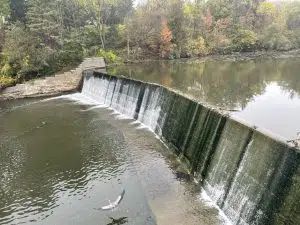
Mark Rinker standing proudly with his new business. (Kate Otterbein / XFM News)
After being sold, the Arva Flour Mill is remaining in business. Locals were panicked that the world-renowned business would be sold for development, just like most of the land in Arva. But the new owner, Mark Rinker, didn’t want that to happen.
“We’ll make sure that we can do everything that we can to preserve the mill for future generations to enjoy. That is even throttling back production of the mill. It would be irresponsible for me, for my business case, to say we need to produce more flour. It would really stress the mill and shorten its lifespan,” says Rinker.
It’s very important to Rinker that the mill stays in the best condition possible.
“The best way to preserve the mill is to use it, but in a responsible fashion. If you were to just stop production, things would go south in a hurry. So we do plan to continue production, but to do so at a very measured rate,” says Rinker.
“I’m glad he’s going to keep it open. I think it’s important to support all of these little businesses, so I will definitely be going back there,” says Kelly Semple, who has spent a lot of time on the Arva Flour Mill property.
Rinker grew up going to the flour mill frequently, so it’s near and dear to his heart.

Gilbert, the red-faced duck, relaxing by the pond at the Arva Flour Mill. (Kate Otterbein / XFM News)
“My relationship with the mill property goes back 50 years. My dad would take me there as a boy. I grew up in northeast London, so I spent a ton of time out at the Fanshawe dam doing some fishing. In 1999, Dad had a business in Arva for a number of years, so that reacquainted my passion for the property. Going and walking the property, spending time by the pond, seeing Gilbert, the red-faced duck,” says Rinker.
These memories are something he is excited to share with his young granddaughter as she grows up on the mill too.
The Arva Flour Mill is right beside Medway Creek, which is the water that flows through the mill and runs the machines. It is the sixth oldest business in Canada and the oldest water-powered flour mill in North America.
“Back in the day, there was no electricity. So they needed the power to turn a heavy millstone, which grinds the wheat into flour. One of the ways to turn the millstone was water. There’s a 100-foot dam on the property and it creates a reservoir. The natural instinct for that stored water is to find its own level, which is about 10 feet below the top of the dam. It turns a water turbine and that turbine is attached to a series of pulleys that makes the flour mill work,” says Rinker.
Rinker is also exploring his options to expand what the Arva Flour Mill produces. Currently, he is looking at bringing another mill for gluten-free flour, and he is looking at bringing a winery and distillery to the lot.






Comments